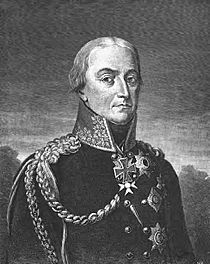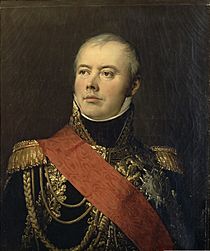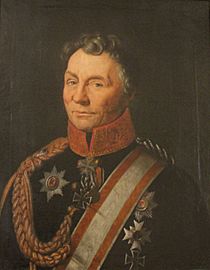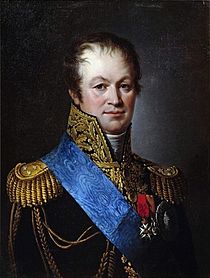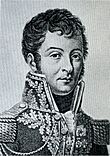Battle of Arnhem (1813) facts for kids
Quick facts for kids Battle of Arnhem (1813) |
|||||||
|---|---|---|---|---|---|---|---|
| Part of the War of the Sixth Coalition | |||||||
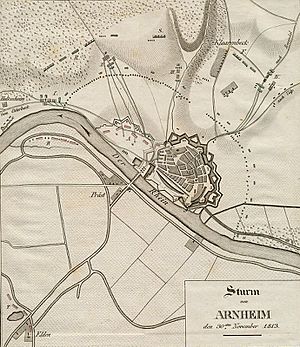 Storm of Arnhem 30 November 1813. |
|||||||
|
|||||||
| Belligerents | |||||||
| Commanders and leaders | |||||||
| Strength | |||||||
| 4,000 | 10,000 | ||||||
| Casualties and losses | |||||||
| 1,500 killed, wounded, or captured 14–15 guns lost |
600–700 killed, wounded, or captured | ||||||
The Battle of Arnhem happened on November 30, 1813. It was a fight between Prussia and France in the city of Arnhem, Netherlands. The Prussian army was led by Friedrich Wilhelm Freiherr von Bülow. The French army was led by Henri François Marie Charpentier.
The Prussians attacked when it was foggy. They broke into the city from different places. After a tough fight, the French had to retreat to Nijmegen. This battle was part of a bigger war called the War of the Sixth Coalition. Arnhem is a city in the Netherlands, located on the Rhine River. It's about 100 kilometers (62 miles) southeast of Amsterdam.
In late 1813, the Prussian army invaded the Netherlands. This invasion helped start a Dutch rebellion against French rule. Marshal Jacques MacDonald, a French commander, told Charpentier to leave Arnhem. But Charpentier ignored the order and lost the battle. After winning, Bülow's army moved west to free Utrecht. They also wanted to support the Dutch people. Later, a British army joined the Prussians. It was led by Thomas Graham, 1st Baron Lynedoch. However, the Prussians and their allies (Russia and Sweden) had some disagreements. This slowed down their efforts to free Holland and Belgium from the French.
Why the Battle Happened
The Coalition armies fought Emperor Napoleon at the Battle of Leipzig in October 1813. Napoleon's army was much smaller than the combined armies of his enemies. He lost many soldiers and had to retreat. By November, Napoleon's army was very weak. Only about 60,000 to 70,000 soldiers were left to defend France.
The countries fighting Napoleon didn't all agree on what to do next. The Russian leader, Czar Alexander I of Russia, wanted to capture Paris. He wanted to remove Napoleon from power. The King of Prussia, Frederick William III of Prussia, usually agreed with the Czar. His people wanted revenge against France. But the Austrian Emperor, Francis I of Austria, was worried. He feared that Russia and Prussia would become too powerful if Napoleon was overthrown. Great Britain, which was paying for much of the war, wanted lasting peace.
Napoleon had made his brother, Louis Bonaparte, the King of Holland in 1806. But in 1810, Napoleon took over the Netherlands completely. The Dutch people were not happy about this. They had to send soldiers to Napoleon's armies. Many Dutch soldiers died in the French invasion of Russia. Also, Napoleon's trade rules, called the Continental System, hurt Dutch businesses. So, the Dutch were ready to rebel against French rule.
In November 1813, a Russian army unit entered Holland. It was led by Alexander von Benckendorff. Soon, more Russian soldiers joined them. The Dutch rebellion started in Amsterdam on November 14-15. The French leader in Holland, Charles-François Lebrun, duc de Plaisance, didn't handle the crisis well. By November 19, the rebels had formed a temporary government. They hoped to bring back the old Dutch royal family.
On November 13, Bülow's Prussian army moved towards the Dutch border. To stop them, Marshal Jacques MacDonald spread his French troops along the Rhine River. MacDonald started moving his forces north to defend the lower Rhine. The French army was getting weaker. Many foreign soldiers left their units. The French had to use customs officers and police to form new army units.
By the end of November, MacDonald had divided his forces into three groups. On the left, there were about 10,000 soldiers. They were supposed to defend the Rhine and other rivers. Bülow's Prussian army was much larger. He had about 30,000 soldiers and 96 cannons.
Bülow was eager to invade Holland. But he couldn't get permission until Great Britain pushed the Prussian government. On November 23, Bülow's advance group of 3,000 men entered Holland. They captured the town of Doesburg. On November 24, Bülow's forces took Zutphen. On the same day, the Russian forces reached Amsterdam. Also on the 24th, the Prussians pushed the French from Velp to Arnhem.
The Battle of Arnhem
The Prussians found the French defending a camp outside Arnhem. The French attacked the Prussian outposts on November 26. They pushed them back for a short time. Later, more Prussian troops arrived. At first, the Prussians wanted to attack Arnhem. But they saw many French troops and cannons. They also learned that 3,000 to 4,000 French soldiers were defending the city.
Marshal MacDonald and Charpentier arrived in Arnhem on November 28 with more French soldiers. MacDonald decided that Arnhem couldn't be defended against a larger force. He went back to Nijmegen. He left Charpentier and 4,000 troops to hold Arnhem.
On the morning of November 29, the French started firing cannons at the Prussians. The Prussians attacked the French camp, but they were pushed back. Charpentier then counterattacked and drove the Prussians back to Velp. MacDonald returned to Arnhem that day. He saw how many Prussian soldiers there were. He realized Charpentier was in danger of being trapped. MacDonald told Charpentier to leave the city. Then he went back to Nijmegen.
For some reason, Charpentier did not follow his orders. He stayed in Arnhem on the morning of November 30. He also made a big mistake by not putting guards at the city gates. Meanwhile, Bülow arrived before dawn. He planned a five-part attack. The attack was delayed by thick fog. During the fog, the Prussians heard horses and wagons crossing the Rhine bridge.
As the fog lifted, Bülow ordered all his troops to attack at 11:00 am. The first attack on the French camp failed. But a second attack pushed the French soldiers back into the city. Charpentier was confused about where the Prussians were attacking. So, the French reacted slowly. One Prussian group quickly took the Velp gate, which had only a few defenders. Other gates also fell quickly. The Prussians rushed into the city. This was because Charpentier had most of his troops on the western side of the city.
Prussian soldiers stormed a strong defense point. Other Prussians climbed the city wall. They faced heavy fire from French cannons. But the Prussians won a fierce fight. The French commander, Marie, was badly wounded and captured. Charpentier himself was wounded and barely escaped. Another French commander, Amey, took charge and led four battalions in retreat across the river.
Three French battalions were trapped inside the city. They fought very hard in the streets. Some escaped, but most were killed or captured. The French tried to burn the bridge, but Prussian engineers put out the fire and fixed it.
What Happened After
The French lost about 500 soldiers killed and wounded. They also lost 1,000 men and 14 cannons captured. The Prussians lost about 600 to 700 soldiers killed and wounded. Charpentier's division lost almost 1,500 men. Two French battalions were almost completely wiped out. The Prussians were a bit disorganized after their big win.
As soon as the bridge was fixed, Bülow sent his cavalry after the French. The retreating French soldiers met more French troops. The chase ended when the French were in a strong position behind a river. MacDonald pulled his troops back to defend another river line. Bülow moved west and took Utrecht on December 2. He then paused to plan his next steps. Two days later, a British army of 8,000 soldiers landed in the Netherlands.
Bülow was annoyed that the newly freed Dutch people didn't want to join the army. British guns meant for the Dutch were given to German soldiers instead. Bülow was also disappointed with the Russian general Wintzingerode. His 18,000 soldiers stayed in Germany and did nothing to help.
Images for kids


